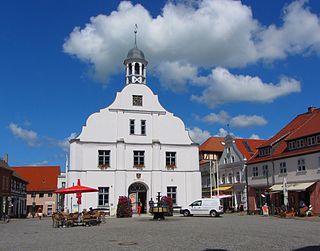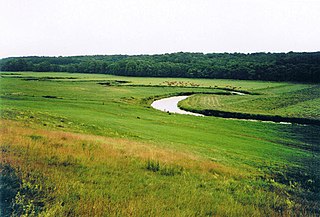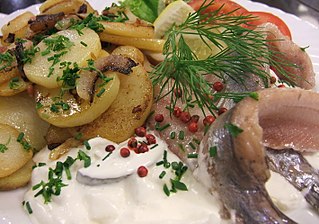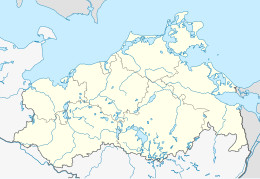
Mecklenburg-Vorpommern, also known by its anglicized name Mecklenburg–Western Pomerania, is a state in the north-east of Germany. Of the country's sixteen states, Mecklenburg-Vorpommern ranks 14th in population; it covers an area of 23,213 km2 (8,963 sq mi), making it the sixth largest German state in area; and it is 16th in population density. Schwerin is the state capital and Rostock is the largest city. Other major cities include Neubrandenburg, Stralsund, Greifswald, Wismar, and Güstrow. It was named after the two regions of Mecklenburg and Vorpommern, and its name means the "nearer part of Pomerania", with the rest now lying in Poland.

Demmin is a town in the Mecklenburgische Seenplatte district, Mecklenburg-Western Pomerania, Germany. It was the capital of the former district of Demmin.

Wolgast is a town in the district of Vorpommern-Greifswald, in Mecklenburg-Vorpommern, Germany. It is situated on the bank of the river Peenestrom, vis-a-vis the island of Usedom on the Baltic coast that can be accessed by road and railway via a movable bascule bridge. In December 2004, the town had a population of 12,725.

Pasewalk is a town in the Vorpommern-Greifswald district, in the state of Mecklenburg-Vorpommern in Germany. Located on the Uecker river, it is the capital of the former Uecker-Randow district, and the seat of the Uecker-Randow-Tal Amt, of which it is not part.

Radogost is, according to medieval chroniclers, the god of the Polabian Slavs, whose temple was located in Rethra. In modern scientific literature, however, the dominant view is that Radogost is a local nickname or a local alternative name of the solar god Svarozhits, who, according to earlier sources, was the chief god of Rethra. Some researchers also believe that the name of the town, where Svarozhits was the main deity, was mistakenly taken for a theonym. A popular local legend in the Czech Republic is related to Radogost.

Burg Stargard is a small town in the Mecklenburgische Seenplatte district, in Mecklenburg-Vorpommern, Germany. It is situated 8 kilometres (5.0 mi) southeast of Neubrandenburg.

The Tollense is a river in Mecklenburg-Vorpommern in northeastern Germany, right tributary of the Peene. It has a total length of 95.8 km.

Fahrenwalde is a municipality in the district of Vorpommern-Greifswald in the east of the German federal state Mecklenburg-Vorpommern. It is administrated by the Amt Uecker-Randow-Tal, which is based in Pasewalk.

Martin Hollstein is a German sprint canoer and Olympic champion. He has been competing since the late 2000s, mostly in kayak single, double or four.

Pomerania during the Early Middle Ages covers the History of Pomerania from the 7th to the 11th centuries.

History of Pomerania (1945–present) covers the history of Pomerania during World War II aftermath, the Communist and since 1989 Democratic era.
Medieval Pomerania was converted from Slavic paganism to Christianity by Otto von Bamberg in 1124 and 1128, and in 1168 by Absalon.

Tollensesee is a zungenbecken lake in Mecklenburg-Vorpommern, Germany. It belongs to the Mecklenburg Lake District. At an elevation of 14.8 m, its surface area is 17.4 km². Its maximum depth is about 46 m. The lake is 10.4 km long and between 1.5 and 2.5 km wide. The entire lake lies within the administrative area of the city of Neubrandenburg. In the south part of the lake there is island Fischerinsel.
Rethra was, in the 10th to the 12th centuries, the main town and political center of the Slavic Redarians, one of the four major Lutician tribes, located most likely in present-day Mecklenburg. It was also a major worship center, devoted to the cult of the Slavic deity Radegast-Swarożyc.

Pomeranian cuisine generally refers to dishes typical of the area that once formed the historic Province of Pomerania in northeast Germany and which included Stettin and Further Pomerania. It is characterised by ingredients produced by Pomeranian farms, such as swede (Wruken) and sugar beet, by poultry rearing, which has produced the famous Pomeranian goose, by the wealth of fish in the Baltic Sea, rivers and inland lakes of the Pomeranian Lake District, and the abundance of quarry in Pomeranian forests. Pomeranian cuisine is hearty. Several foodstuffs have a particularly important role to play here in the region: potatoes, known as Tüften, prepared in various ways and whose significance is evinced by the existence of a West Pomeranian Potato Museum, Grünkohl and sweet and sour dishes produced, for example, by baking fruit.

The Permin is a bay in the Saaler Bodden lagoon south of Wustrow in northeast Germany. Originally, the Permin was a channel between the Saaler Bodden and the Baltic Sea and the southern estuarine channel of the River Recknitz. It borders on the Fischland in the south.

The Region of Stralsund belonged to the Prussian Province of Pomerania and existed from 1818 to 1932.

Historical Western Pomerania, also called Cispomerania,Fore Pomerania, Front Pomerania or Hither Pomerania, is the western extremity of the historic region of Pomerania forming the southern coast of the Baltic Sea. Western Pomerania's boundaries have changed through the centuries as it belonged to various countries such as Poland, the Duchy of Pomerania, Sweden, Denmark, as well as Prussia which incorporated it as the Province of Pomerania.

Lel and Polel are Polish divine twins, first mentioned by Maciej Miechowita in the 16th century where he presents them as equivalents of Castor and Pollux and the sons of the goddess Łada, the equivalent of Leda. There is no complete agreement about the authenticity of the cult of Lel and Polel.
Hans-Joachim Griephan is a German journalist, publisher and founder of the "Wirtschaftsinformationsdienst" published since 1964, the Griephan Briefe.





















